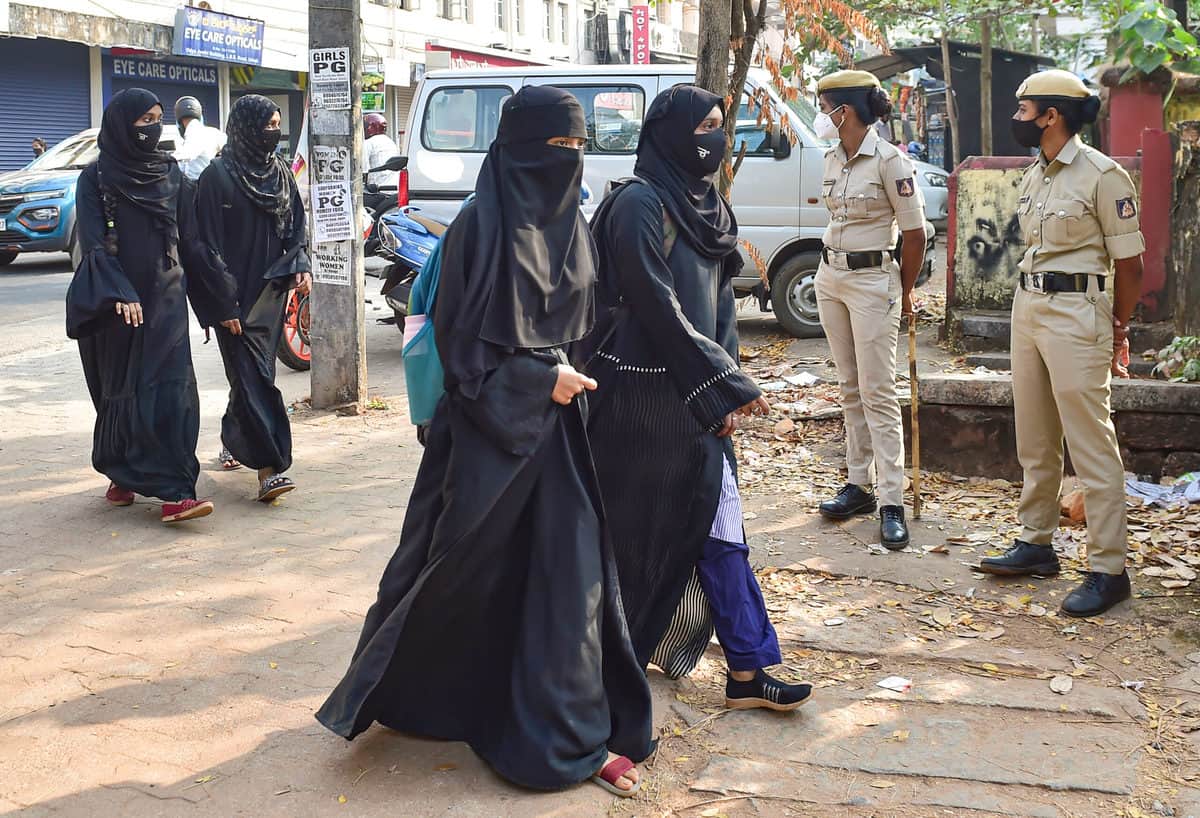

Hyderabad: As the hijab row rages on, views for and against it are being aired freely. Like any other issue, people across the spectrum have jumped into the debate and are expressing their personal opinion on hijab when the matter is entirely religious in nature.
What Muslims eat and wear have always been a bone of contention. But it’s a pity that their sartorial choice has now come in the way of education, a fundamental right. With the hijabi students determined to take the controversy head-on, it is better to lift the veil from the confusion surrounding the Islamic head covering. The argument being put forth by many, including Muslims, is that everyone has a right to choose what one likes to wear. But the truth is that hijab is fardh (obligatory) in Islam and has its roots in the Quran and Sunnah. The believing Muslimah (observant Muslim woman) has no choice in the matter. She has to don the religion-appropriate covering or face the wrath of the Creator in the hereafter.
The Islamic ruling about women’s dress clearly stipulates that the clothing should not show the body or its shape and a head covering that completely covers the hair, ears and neck. In the matter of clothing, modesty is necessary for both men and women but a greater degree of modesty is required for women especially in the covering of feminine elegance. The Quran commands women to draw their veils over their bosoms and not to display their charm except to their husbands. The Prophet of Islam clearly stated that within the limits prescribed by Allah one is free to eat and wear what one likes. Those who have implicit faith in Allah (swt) as the Creator, dare not deny the Islamic shariah which enjoins upon women to hide their faces from other people, a practice prevalent during the time of the Prophet. “Though the veil has not been specified in the Quran, it is Quranic in spirit”, says Maulana Sayyid Abul A’la Maududi, one of the outstanding Islamic thinkers and writers.
Dressing modestly, therefore, is not a choice but a religious obligation for Muslim woman. It tells the onlookers that she should be treated respectfully much the same way as an executive in business suit should be taken seriously. Islamic scholars are unanimous in their view that the ‘awrah’ (parts of the body which must be covered with clothing) of a Muslim woman is all her body with the exception of her hands and face. This rule applies in all cases, including the Haj. Thus it is clear from the Quranic injunctions that hijab is an obligation in Islam. However, there is a difference of opinion about covering of the face and hands. While some jurists say face must be covered others maintain that it is merely a recommended act.
There are some conditions governing hijab etiquette:
1. It must cover the whole body.
2. It must not be tight or transparent.
3. It must not delineate the parts of the body, especially those that are sexually attractive.
4. It must not be a dress that is usually worn by men.
The western propaganda has fed the myth that women in Islam are a suppressed lot with their rights curbed and movement curtailed. But is it really so? There are any number of Muslim women occupying important positions while observing the hijab. Some may see the hijab as a regressive practice, but many women feel comfortable and empowered in it. There are many trailblazers like Raffia Arshad, who functions as a judge in UK, wearing a hijab. For Salva Fatima of Hyderabad hijab has not come in her way of becoming a pilot. There are no dearth of such examples where women are leaving their mark in different facets of life while adhering to the veil.
Purdah is instinctively a womanly trait, a part of womanly modesty. This is clear from how even some non Muslim women cover their heads and faces. Former President, Pratibha Patil, is a case in point. During her five year term she was never seen without the ‘pallu’ covering her head. Former Prime Minister, Indira Gandhi, too often covered her head in public. Moreover, it is a custom in the Hindi belt region of the country for married Hindu, Jain and Sikh women to cover their heads and faces with the loose end of sari. When such is the case why the hue and cry over Muslim women’s faith symbols?
Trouble is there is lot of ignorance about Islamic injunctions concerning modesty and hijab. The word ‘hijab’ is now being interpreted to mean head scarf while it is much more. It is a comprehensive term with deeper connotations. It includes woman’s covering her body and concealing her adornments. Hijab also governs a woman’s conduct and behaviour in relation to the opposite sex. Those observing hijab of clothing is observing it in a limited sense. According to ulema hijab of clothes should be followed by hijab of eyes, hijab of heart, hijab of thought and hijab of intention. The term used in the Quran for head-veil is khimar. Many who claim to have knowledge think there is nothing in the Quran or Sunnah which says women have to cover up in front of non-mahram men (persons with whom marriage is permissible). Look up Sura al-Noor verse 31:
And tell the believing women to restrain their looks, and to guard their private parts, and not to show off their adornment except what is apparent thereof, and to draw their head-veils all over juyoobihinna (ie. their bodies, faces, necks and bosoms) and not to reveal their adornment except to their husbands, or their fathers, or their husbands’ fathers, or their sons, or their brothers or their brothers’ sons or their sisters’ sons or their (Muslim) women.
In Sura al-Ahzaab verse 59 Allah says: O Prophet! Tell your wives and your daughters and the women of the believers to draw their cloaks (veils) all over their bodies. That is more proper, so that they will be recognised and not harassed. Allah is Forgiving and Merciful.
So to say that veil or head covering is not essential part of Islam is wrong. Can there be a clearer injunction that this? Jilbab in Arabic means a loose outer garment that hides a woman’s body from head to foot. Quran not merely commands women to wear the cloak but also to pull it over their faces. Of course there are many Muslim women who do not observe hijab. Their action doesn’t necessarily mean that hijab is not part of Islam. Similarly, many Muslims are not regular in their prayers. And to conclude that namaz is not essential will be taking the argument too far. There are non-practicing persons in every religion. And their acts should not be taken as criteria.
Are Muslim girls now left with a Hobson’s choice – education or hijab? No way. Both are essential and ordained by Allah. Muslim girls can neither give up hijab nor abandon their studies. One hopes wiser counsel prevails and divisive political agenda doesn’t fuel the issue.
The great satirist, Akbar Allahabadi’s verse on the veil sums up the issue in the best possible manner. He says:
Be-parda kal jo aaiin nazar chand bibayan
Akbar zamin mein ghairat-e-qaumi se gad gaya
Puchha jo main ne aap ka parda wo kya hua
Kahne lagin ki aql pe mardon ke pad gaya
(Yesterday, as some bareheaded ladies were seen
Akbar bemoaned with a sense of shame and pain
I asked politely, ladies, where your veil has gone?
Said they, it now covers the wisdom of men)

